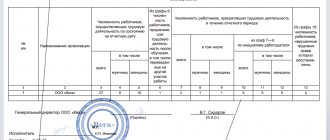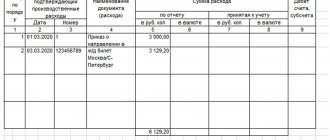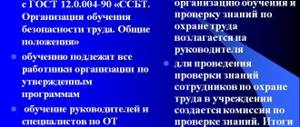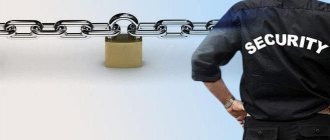Responsible occupational safety specialists are vested with powers in the field of production safety. The conferment of such powers occurs through the issuance of an appropriate management order.
The order specifies the rights and obligations, position and personal data.
The main requirement for such a position is the availability of special knowledge in the field of labor protection, obtained through appropriate education in a special training center.
After receiving the appropriate certificate and issuing an order from the management, the specialist is given the corresponding responsibilities, including issuing instructions in production if appropriate grounds arise.
There is such a right
Let us immediately note that the Labor Code of the Russian Federation does not say anything about the instructions of the labor protection service. Including article 217, which is devoted to the creation of this service in the organization. The regulation in question is discussed in the Recommendations for organizing the work of the occupational safety service at an enterprise. They were approved by Resolution of the Ministry of Labor of Russia dated February 8, 2000 No. 14 (hereinafter also referred to as Resolution No. 14).
Based on Section IV of Decree No. 14, which lists the fundamental rights of occupational safety and health workers, they can:
- present to the heads of departments of the organization and other officials of the enterprise orders to eliminate violations of labor protection requirements discovered during inspections;
- control their implementation.
As a general rule, the order is issued by an engineer or a specialist from the labor protection service.
Please note that the instruction of the occupational safety engineer is mandatory.
The bottom line is that employees of the organization's labor protection service can visit and inspect the production, office and household premises of the enterprise at any time of the day or night and without any obstacles. After reviewing the relevant documentation based on the results of these checks, they can submit orders.
Also see “Rights of the Occupational Safety and Health Service”.
We also note that the control powers of a specialist and/or engineer of the labor protection service are quite broad. In particular, this check:
- compliance by personnel with regulatory requirements on labor protection;
- availability and correct use of personal and collective protective equipment;
- investigation and recording of accidents at work;
- compliance with the instructions of government agencies. supervision and control over compliance with labor protection requirements;
- conducting a special assessment of working conditions;
- timely carrying out by the relevant services of the necessary tests and technical examinations of equipment, machines and mechanisms;
- timely training on labor protection, testing knowledge of these requirements and all types of instruction on labor protection, etc.
For more information about this, see “What control is exercised by the labor protection service.”
Example of log entry
In order to fulfill the requirements of office work and GOST standards for document flow, such an act must be registered by the internal bodies of the company's division, as well as by government agencies when issuing it. To do this, the company must have a special accounting journal in which the following information is entered:
- Date of incoming correspondence or other date of receipt of such a document;
- His internal number, as well as assignment of the company’s internal number;
- A brief summary of such an act, with an explanation of the identified shortcomings;
- The period for consideration and response for an enterprise or a decision by a government organization;
- The responsible executor of such an act is directly responsible for monitoring the elimination of identified deficiencies.
Prescription form
The Russian Ministry of Labor offers the following form on which it is advisable to fill out an order from a specialist from the labor protection service:
As you can see, the order in question must have the following details:
- legal name of the enterprise;
- date of;
- number;
- to whom it is addressed (full name of the employee and position);
- department name;
- reference(s) to legal regulations governing labor protection;
- proposal to eliminate detected shortcomings and violations;
- list of violations;
- deadline for eliminating each of them;
- subsequent note about liquidation of the violation (or non-liquidation);
- when to report compliance with the order;
- method of communication;
- the specialist who issued the order (signature, date, full name and position);
- the person who received the order (signature, date, full name and position);
- who controlled the elimination of violations (signature, date, full name and position).
Also see “Functional responsibilities of a specialist (leading specialist) in labor protection”.
Read also
15.10.2017
Sample form of an occupational safety order
In the annex to the recommendations for organizing the work of the security service, approved by Resolution of the Ministry of Labor of the Russian Federation dated 02/08/2000 No. 14, a form for an instruction from an engineer or occupational safety specialist is proposed. At the same time, clause 8.2 of the appendix to this resolution states that the approved form is recommended for use. From this we can conclude that the employer has the right to independently develop and approve his own sample order form at the enterprise by local act.
| Download the prescription form |
Based on the fact that the form has already been developed, it is much easier to use it. If there is a need to develop your own sample, the form from the appendix to the above recommendations can become the basis for it.
When is it exhibited?
The result of scheduled or unscheduled inspections is the drawing up of a report by the inspector - an act. If, during an inspection at an enterprise, facts of non-compliance with labor legislation were revealed, a State Labor Inspectorate employee issues an order that obliges the employer to eliminate the identified violations and, if necessary, punish those responsible.
This document may contain requirements such as:
- Eliminate detected violations;
- Restore the employee's rights;
- Impose disciplinary punishment or dismiss the persons responsible for the offense.
The employer is given a specific period to fulfill the requirements (Article 22 of the Labor Code of the Russian Federation). Failure to meet the deadline may result in administrative liability.
This means that the more often an employer receives a decision to eliminate violations, the more often they will come to him with an inspection.
How to answer it?
After the employer has complied with the inspector’s requirements, he is obliged to report this to the State Tax Inspectorate. As a rule, the response to the order of the labor inspectorate is drawn up in the form of a written report and submitted by mail or in person to the inspection body.
But, then the question arises, why is this compliance letter needed? And it is needed, firstly, to increase the efficiency of interaction between the employer and the regulatory body, and secondly, so as not to once again bother the employer with inspections.
Fine for failure to comply with the order of the state labor inspector on time
Expert opinion
Semenov Alexander Vladimirovich
Legal consultant with 10 years of experience. Specializes in the field of civil law. Member of the Bar Association.
Important! Failure to comply with the order of the state labor inspector on time entails liability for the employer under the Code of Administrative Offenses of the Russian Federation (hereinafter referred to as the Code of Administrative Offenses of the Russian Federation).
So, according to Part 23 of Art. 19.5 of the Code of Administrative Offenses of the Russian Federation, the employer faces a fine for failure to comply with the order of the state labor inspector in the following amount:
However, failure to comply with an order may not always depend on the employer. Thus, the employer does not face sanctions if:
- the order does not contain specific actions that the employer must perform;
- or they may be interpreted differently.
Note! In some cases, if there are extenuating circumstances, the employer may request a deferral of execution of the order. To do this, he needs to send a corresponding petition.
In addition, the liability of organizations under the Code of Administrative Offenses is described in the article Administrative liability of legal entities - concept.
Thus, the response to the labor inspector’s order is drawn up by the employer in free form and includes information about the implementation of measures to comply with the inspector’s requirements. The response must be accompanied by copies of documents confirming the implementation of these activities.
Sending a response helps to avoid an additional unscheduled inspection by Rostrud after the expiration of the period allotted for the execution of the order.
Any enterprise, regardless of its organizational form, undergoes labor inspection inspections. As a result, the employer receives an act, and in some cases an order.
How to competently draw up a response letter to a GIT order, what is necessary for this - all this will be discussed in this article.
Standards for the use of personal protective equipment at the enterprise
If the activity of an enterprise falls under the conditions described above, the employer is obliged to provide its employees with personal protective equipment, as well as monitor compliance with the standards for their use in work, storage, etc.
| Standards for the use of personal protective equipment (PPE) | Description |
| Shelf life of PPE | For each personal protective equipment, the manufacturer sets a maximum service life. Exceeding this period can be dangerous due to the loss of certain properties necessary to ensure the safety of the worker. |
| Safety of use | Personal protection should be as close as possible to the conditions of the activity for which they are used. Derogation or relaxation of the requirements for the use of these means can lead to fatal consequences for the life or health of the employee. |
| Compliance with physiological indicators | Personal protective equipment must correspond to the physiological characteristics of the worker and, in some cases, be selected individually, taking into account height, weight and other physiological indicators |
| Issuance of PPE to employees | The employer must provide free PPE to employees. At the same time, they remain the property of the enterprise and are returned to them upon dismissal of the employee. In the event of premature decommissioning due to the fault of an employee, the employer has the right to write off the damage from the employee’s wages |
| Certified protection products | When purchasing personal protective equipment, the employer must verify compliance with existing standards. For this purpose, the supplier usually provides the necessary copies of quality certificates, as well as documentation with instructions for use |
Important! Purchasing personal protective equipment from certified suppliers allows the employer to return part of the funds spent on the purchase through the social insurance fund.
When is a State Tax Inspection carried out?
Response to the order of the labor inspectorate
In accordance with Art. 360 of the Labor Code of the Russian Federation, the State Labor Inspectorate is an authorized body that monitors employers for their compliance with labor legislation.
The law provides for the labor inspectorate to conduct scheduled and unscheduled inspections of organizations and individual entrepreneurs acting as employers.
Scheduled inspections of the State Labor Inspectorate are carried out on the basis of an approved schedule, drawn up in accordance with the risk categories assigned to employers based on the Federal Law-294 procedure:
- inspections of organizations from the high-risk category are carried out once every 2 years;
- employers from the significant risk category are inspected by the State Tax Inspectorate once every 3 years;
- organizations in the medium risk category can expect a scheduled inspection by the labor inspectorate at least once every 5 years;
- for organizations in the moderate risk category, GIT inspections are carried out once every 6 years;
- For employers classified as low risk, scheduled inspections are not provided.
The schedule of scheduled inspections that will be carried out in the current reporting year can be found on the official website of Rostrud (https://www.rostrud.ru/control/plani_proverok/).
The State Tax Inspectorate has the right to conduct unscheduled inspections of employers if the following grounds exist:
- Employee complaint . The receipt by the State Labor Inspectorate of an employee’s application, which contains complaints about the employer’s violation of the current labor legislation, is the basis for the labor inspectorate to conduct an unscheduled inspection. The complaint form to the labor inspectorate can be downloaded here ⇒ Sample complaint to the labor inspectorate.
- Expiration of the order . If, based on the results of a previous inspection, the State Labor Inspectorate issued an order to the employer, then upon the expiration of such an order, the labor inspectorate has the right to order an unscheduled inspection.
- Order of the Prosecutor's Office, Government, President of the Russian Federation. The basis for an unscheduled inspection of the Labor Inspectorate may be an order from the head of the labor inspection body, drawn up on the basis of the requirements of the Prosecutor's Office, the Government or the President of the Russian Federation.
Order of a labor protection specialist (filling procedure, sample)
A sample instruction from a labor protection engineer , which is necessary to simplify the further preparation of instructions, is quite simple to draw up, using the form offered by the legislator in Resolution of the Ministry of Labor of the Russian Federation No. 14. It can be filled out with one’s own hand or using technical means, such as a computer.
Filling is done in the following order:
- At the beginning of the document the name of the organization (full and abbreviated) is indicated, the date is indicated and the serial number of the order is indicated. As a rule, the organization has a special journal for recording instructions - it is from this that the serial number is taken.
- The next point is the determination of the official to whom the order is issued. It is necessary to indicate not only the full name, but also the position and structural unit of the enterprise in which the labor protection engineer works.
- Then the person who issues the order must refer to the specific articles of the regulations on labor protection on the basis of which he acts.
- Next, the legislator proposes to list violations in the form of a table, which consists of 4 columns, which indicate:
- number;
- identified violations;
- elimination deadlines;
- elimination information.
- The following indicates the date by which the violator is obliged to report the elimination of violations.
- The final point is information about who issued the document and who received it, with a transcript of the signature, indicating the position and date.
- The last line in the order is a control line and is filled in if all the violations specified in the document are eliminated.









